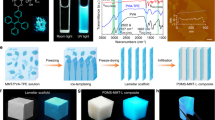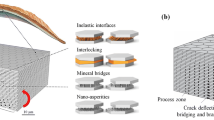Abstract
We prepared hybrid aluminum oxide (Al2O3)/polymethyl methacrylate (PMMA) composites with tunable lamellae, produced through a two-step synthetic method: fabrication of inorganic scaffolds via ice-templating, followed by organic infiltration polymerization as a substitute for the sublimed ice. The final lamellar hybrid products show anisotropic physical properties. The thermal conductivity in both principal directions was determined for three different samples as a function of temperature (∼3 K–300 K). Typical room temperature thermal conductivities are in the range of 0.5–2.5 W/(m K), depending on the composition and direction. Across the lamellae, the thermal conductivity is well modeled by a linear series of thermal resistors, and along the lamellae it is well represented by parallel thermal resistors of continuous slabs of PMMA and ∼200-μm long slabs of Al2O3, joined by PMMA. From the thermal conductivity perspective, the Al2O3/PMMA composite is a nacre mimic.











Similar content being viewed by others
References
V.R. Maria, C. Montserrat, and G. Blanca: Medical applications of organic-inorganic hybrid materials within the field of silica-based bioceramics. Chem. Soc. Rev. 40(2), 596–607 (2011).
R.A.S. Ferreira, P.S. Andre, and L.D. Carlos: Organic-inorganic hybrid materials towards passive and active architectures for the next generation of optical networks. Opt. Mater. 32(11), 1397–1409 (2010).
P. Kumar and V.V. Guliants: Periodic mesoporous organic-inorganic hybrid materials: Applications in membrane separations and adsorption. Microporous Mesoporous Mater. 132(1–2), 1–14 (2010).
K. Tsuru, S. Hayakawa, and A. Osaka: Cell proliferation and tissue compatibility of organic-inorganic hybrid materials. Key Eng. Mater. 377, 167–180 (2008).
U. Schubert: Catalysts made of organic-inorganic hybrid materials. New J. Chem. 18(10), 1049–1058 (1994).
G.D. Combarieu, M. Morcrette, F. Millange, N. Guillou, J. Cabana, C.P. Grey, I. Margiolaki, G. Ferey, and J.M. Tarascon: Influence of benzoquinone sorption on the structure and electrochemical performance of the MIL-53(Fe) hybrid porous material in a lithium-ion battery. Chem. Mater. 21(8), 1602–1611 (2009).
C. Sanchez, H. Arribart, and M.M.G. Guille: Biomimetism and bioinspiration as tools for the design of innovative materials and systems. Nat. Mater. 4, 277–288 (2005).
W. Suchanek and M. Yoshimura: Processing and properties of hydroxyapatite-based biomaterials for use as hard tissue replacement implants. J. Mater. Res. 13(1), 94–117 (1998).
H. Yamamoto, Y. Kojima, T. Okuyama, W.P. Abasolo, and J. Gril: Origin of the biomechanical properties of wood related to the fine structure of the multilayered cell wall. J. Biomech. Eng. 124, 432–440 (2002).
L. Estevez, A. Kelarakis, Q.M. Gong, E.H. Da’as, and P.G. Emmanuel: Multifunctional graphene/platinum/nafion hybrids via ice templating. J. Am. Chem. Soc. 133, 6122–6125 (2011).
S. Nayar, A.K. Pramanick, A. Guha, B.K. Mahato, M. Gunjan, and A. Sinha: Biomimetic synthesis of hybrid nanocomposite scaffolds by freeze-thawing and freeze-drying. Bull. Mater. Sci. 31(3), 429–432 (2008).
S. Deville, E. Saiz, R.K. Nalla, and A.P. Tomsia: Freezing as a path to build complex composites. Science 311, 515–518 (2006).
Y-W. Moon, K-H. Shin, Y-H. Koh, W-Y. Choi, and H-E. Kim: Production of highly aligned porous alumina ceramics by extruding frozen alumina/camphene body. J. Eur. Ceram. Soc. 31, 1945–1950 (2011).
M.C. Gutierrez, M.L. Ferrer, and F. de Mon: Ice-templated materials: Sophisticated structures exhibiting enhanced functionalities obtained after unidirectional freezing and ice-segregation-induced self-assembly. Chem. Mater. 20, 634–648 (2008).
C. Suwanchawalit, A.J. Patil, R.K. Kumar, S. Wongnawa, and S. Mann: Fabrication of ice-templated macroporous TiO2-chitosan scaffolds for photocatalytic applications. J. Mater. Chem. 19, 8478–8483 (2009).
M.B. Jakubinek, C. Samarasekera, and M.A. White: Elephant ivory: A low thermal conductivity, high strength nanocomposite. J. Mater. Res. 21, 287–292 (2006).
L.P. Tremblay, M.B. Johnson, U. Werner-Zwanziger, and M.A. White: Relationship between thermal conductivity and structure of nacre from Haliotis fulgens. J. Mater. Res. 26(10), 1216–1224 (2011).
E. Munch, M.E. Launey, D.H. Alsem, E. Saiz, A.P. Tomsia, and R.O. Ritchie: Tough, bioinspired hybrid materials. Science 322, 1516–1520 (2008).
M.E. Launey, E. Munch, D.H. Alsem, H.B. Barth, E. Saiz, A.P. Tomsia, and R.O. Ritchie: Designing highly toughened hybrid composites through nature-inspired hierarchical complexity. Acta Mater. 57, 2919–2932 (2009).
B-Z. Zhan, M.A. White, and M. Lumsden: Bonding of organic amino, vinyl, and acryl groups to nanometer-sized NaX zeolite crystal surfaces. Langmuir 19, 4210 (2003).
O. Maldonado: Pulse method for simultaneous measurement of electric thermopower and heat conductivity at low temperatures. Cryogenics 32, 912 (1992).
Z.J. Yin, S.Y. Tao, X.M. Zhou, and C.X. Ding: Evaluating microhardness of plasma sprayed Al2O3 coatings using vickers indentation. J. Phys. D: Appl. Phys. 40, 7090–7096 (2007).
S. Deville, E. Saiz, and A.P. Tomsia: Freeze casting of hydroxyapatite scaffolds for bone tissue engineering. Biomaterials 27, 5480–5489 (2006).
S. Deville: Freeze-casting of porous ceramics: A review of current achievements and issues. Adv. Eng. Mater. 10, 169 (2008).
H.F. Zhang, I. Hussain, M. Brust, M.F. Butler, S.P. Rannard, and A.I. Cooper: Aligned two- and three-dimensional structures by directional freezing of polymers and nanoparticles. Nature 4, 787–793 (2005).
K. Lu, C.S. Kessler, and R.M. Davis: Optimization of a nanoparticle suspension for freeze-casting. J. Am. Ceram. Soc. 89(8) 2459–2465 (2006).
C.D. Munro and K.P. Plucknett: Aqueous colloidal characterization and forming of multimodal barium titanate powders. J. Am. Ceram. Soc. 92, 2537–2543 (2009).
S. Deville, E. Maire, G. Bernard-Granger, A. Lasalle, A. Bogner, C. Gauthier, J. Leloup, and C. Guizard: Metastable and unstable cellular solidification of colloidal suspensions. Nat. Mater. 8(12), 966–972 (2009).
B. Zhang and F.D. Blum: Thermogravimetric study of ultra thin PMMA films on silica: Effect of tacticity. Thermochim. Acta 396, 211–217 (2003).
W. Yang, N. Kashani, X.W. Li, G.P. Zhang, and M.A. Meyers: Structural characterization and mechanical behavior of a bivalve shell (Saxidomus purpuratus). Mat. Sci. Eng. C 1–6 (2010).
V. Ziv, H.D. Wagner, and S. Weiner: Microstructure-microhardness relations in parallel-fibered and lamellar bone. Bone 18(5), 417–428 (1996).
C. Sachs, H. Fabritius, and D. Raabe: Hardness and elastic properties of dehydrated cuticle from the lobster Homarus americanus obtained by nanoindentation. J. Mater. Res. 21(8), 1987–1995 (2006).
M.A. White: Physical Properties of Materials (CRC Press, Boca Raton, FL, 2012).
D.G. Cahill, S-M. Lee, and T.I. Selinder: Thermal conductivity of κ-Al2O3 and α-Al2O3 wear-resistant coatings. J. Appl. Phys. 83(11), 5783–5786 (1998).
D. Chu, M. Touzelbaev, K.E. Goodson, S. Babin, and R.F. Pease: Thermal conductivity measurements of thin-film resist. J. Vac. Sci. Technol. B 19(6), 2874–2877 (2011).
D.A.G. Bruggeman: Calculation of various physics constants in heterogeneous substances. Ann. Phys. 24, 636–679 (1935).
C.P. Wong and R.S. Bollampally: Thermal conductivity, elastic modulus, and coefficient of thermal expansion of polymer filled with ceramic particles for electronic packaging. J. Appl. Polym. Sci. 74, 3396–3403 (1999).
F. Hojo, H. Kagawa, and Y. Takezawa: Synthesis of a polymer composite with networked α-alumina fiber and evaluation of its thermal conductivity. J. Ceram. Soc. Jpn. 119(7), 601–604 (2011).
D.C. Moreira, L.A. Sphaier, J.M.L. Reis, and L.C.S. Nunes: Experimental investigation of heat conduction in polyester-Al2O3 and polyester-CuO nanocomposites. Expt. Thermal Fluid Sci. 35, 1458–1462 (2011).
Acknowledgments
We thank Robert L. White, Josef W. Zwanziger, Peng Zhang, Jeff Dahn, Ping Li, and Patricia Scallion for help in this work. This research was financially supported by NSERC, and the Canada Foundation for Innovation, Atlantic Innovation Fund and other groups which fund the Facilities for Materials Characterization managed by the Institute for Research in Materials at Dalhousie University.
Author information
Authors and Affiliations
Corresponding author
Rights and permissions
About this article
Cite this article
Chen, R., Johnson, M.B., Plucknett, K.P. et al. Thermal conductivity of tunable lamellar aluminum oxide/polymethyl methacrylate hybrid composites. Journal of Materials Research 27, 1869–1876 (2012). https://doi.org/10.1557/jmr.2012.112
Received:
Accepted:
Published:
Issue Date:
DOI: https://doi.org/10.1557/jmr.2012.112




